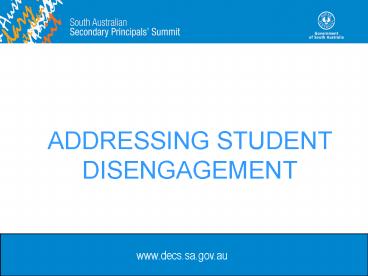www'decs'sa'gov'au - PowerPoint PPT Presentation
1 / 22
Title:
www'decs'sa'gov'au
Description:
(Riddell, 2004, pp.1 5). The decision to quit (school) is a gamble they will continue to pay for, for the ... Teese and Polesel, in Mission Australia, 2006 ... – PowerPoint PPT presentation
Number of Views:22
Avg rating:3.0/5.0
Title: www'decs'sa'gov'au
1
ADDRESSING STUDENT DISENGAGEMENT
www.decs.sa.gov.au
2
- Those who acquire additional schooling generally
earn more over their lifetimes, achieve higher
levels of employment, and enjoy more satisfying
careers - (Riddell, 2004, pp.15).
3
- The decision to quit (school) is a gamble they
will continue to pay for, for the rest of their
lives, counting on the market to find them the
place they could not find at school. - Teese and Polesel, in Mission Australia, 2006
4
- Young people who do not complete their SACE or
equivalent are about six times as likely to
experience poor transitions to work, compared to
those who do complete school. - (Strategic Policy Unit, 2007)
5
- Seven years on, those who have left early are
still only marginally attached to the workforce
and 20 of early leavers have been in that
position for most of the time since leaving
school - (HYPAC, 2008)
6
In September 2009, there were 47,200 young
people (15 to 24 years) at risk in the labour
market in South Australia. This figure
represents 21.4 of 15 to 24 year olds compared
with 20.5 nationally. (DFEEST, 2009,
Workforce information service,
http//www.workforceinfoservice.sa.gov.au/workforc
einfo/youthparticipationatrisk
7
- Early school leaving and lower levels of
education cost Australia an estimated 2.6
billion a year in higher social welfare, health
and crime prevention - Education Foundation Australia(2007)
8
When young people leave school early, this
results in
- lower employment rates
- increased welfare payments
- lower productivity
- a lower tax revenue for Australia.
9
- We simply cannot afford to have even a small
proportion of young people being left out of the
opportunity to work, study, continually re-skill
and contribute to our economy - (MCEETYA, 2006, p.7)
10
Those not completing school may experience
- 4 times poorer mental and physical health
- higher likelihood of child abuse and neglect as
parents - higher instances of homelessness, drug and
alcohol abuse and criminal activity - 9 times likely increase in mortality rates
- Education Foundation Australia (2007)
11
- Poverty, low parental education and single
parent family structure are not simply proxies
for a single underlying disadvantage, but have
additive effects on the life chances of
children. - (Bauman et al, in Vinson, 2007, p.8)
12
- The Communities Making a Difference National
Partnership will assist all schooling sectors by
providing additional resources and strategies to
better support young people at risk of
disengaging or have already disengaged
13
(adapted from Munns, G.,2004)
14
- The more negative life events an adolescent has
the more likely they are to engage in problem
behaviours and the less likely they are to engage
in a wide range of positive activities. - Fuller, 2005, p.21
15
DECS
- A student centred approach
- Mentoring and Youth Development
- Aboriginal Mentoring
- Innovative Community Action Networks
16
Catholic Education
- Expand
- Case Management
- Monitoring reporting for at risk
- Indigenous Refugee student cohort support
17
INDEPENDENT SCHOOLS
- Strengthened partnerships with
- Parents
- Specialists
- Community facilities
- Targeted support for targeted cohorts including
Indigenous students
18
- The approach of youth development is to help
youth become socially, morally, emotionally,
physically, and cognitively competent. It
concentrates on building strengths rather than
working to diminish youths deficits or risks. - McDonald (2002)
19
Mentoring can
- reduce the likelihood of students skipping
classes - improve school attendance and performance
- improve students relationships with family and
friends - improve skills
- reduce the likelihood of teenage pregnancy
- decrease drug use/abuse
- increase a sense of self worth.
- improve retention rates at school
- improve / enhances career options
- reduce anti-social behaviour e.g. vandalism
- reduce behaviour management intervention the
ensuing paperwork and follow up - improve wellbeing and morale of students
20
ICAN and a Flexible Learning Option enrolment
strategy
- Individual case management
- Individualised accredited learning
- Flexible delivery
- Tailored to young person
- School and community partnerships
21
- the most important factor to connect young
people to school that was discussed by students
was that of relationships with teachers and with
other students - the social environment and their
friendships. A large part of this importance is
related to the level of responsibility and mutual
respect generated by these relationships. - Commonwealth Department of Education, Training
and Youth Affairs entitled Building
relationships making education work
22
(No Transcript)































